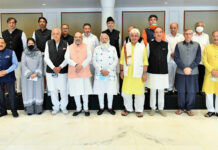by M Saleem Beg
Kashmir has always prided about its uniqueness of possessing a recorded history of more than three millennia even after discounting the mythical narrations emanating from generations of ancient and medieval historians. However, along the way, it lost its course and while modern historical processes and knowledge systems were established as a discipline in other parts of the subcontinent, Kashmir history writing stagnated and almost cocooned into its past.
The recommended histories for a modern historian revolved just around Kashir, GMD Sofi (1949), History of the struggle for freedom’ by P N Bazaz (1954), A History of Kashmir, P N K Bamzai (1962), Kashmir under Sultans by Mohibul Hassan (1959). Rajatarangni, translated into English in 1900 is a poetic representation, though a rich reference but like similar period works generous and liberal with assessments and descriptions.
The Valley of Kashmir by Sir Walter Lawrence (1895) is a combination of travelogue, description of Kashmiris natural and political history and documentation with the prevailing assertions and morphologies. All these writings had the benefit of Kashmiris tradition of recording history. Mostly in Persian, the lingua franca of post-medieval period, these comprised of hagiographies of saints and kings, chronologies as well as those instructed and guided by royal patronage.
Over the years, history writing evolved as a discipline and led the development of social sciences. History is now practiced as ‘an unending dialogue between the present and the past and chief function of a historian is to understand the past as a key to the understanding of present’. None of the past histories of Kashmir measures up to this now widely accepted definition.
Even while, as stated by Balraj Puri, a columnist and a public intellectual of the late 20th century,’ the problem of Kashmir is its history’, there was not much of the written record to interpret this ‘history’. It is only the last about slightly more than two decades when a young genre of highly competent academicians and scholars from across the continents applied interdisciplinary processes to Kashmir, its distant and immediate past.
This, in the words of one of the most credible historians of this class, Chitralekha Zutshi, defined as ‘an ethnographic approach-talking to people and providing a space for them to share their memories of the past verbally and through their family textual collections. This approach revealed a hitherto untapped archive in the Kashmiri language, in the form of poetry, short stories, stories that added new flavour to the debates about decline, loss, belonging’. This approach ‘informed on relationship among ideas of religion, region and nation’.
Even while the modern scholarship has been delving deep into the past so that an understanding of the tumultuous present is achieved, other aspects of human history deserve to be explored in order to contribute to the task of ‘understanding the present by examining the past’. Archeology and architecture is an essential component of this revaluation of the context. We are aiming at finding answers to, by now identified ‘identity crises’ through the medium of architecture.
The wide swath of land called Kashmir has from the very times immemorial, been imagined as a heavenly setting, a spiritual space with parallels drawn with the ultimate of divine creation, the heaven. Within the Indian context, the region is also renowned for its crafts of which the Shawl making has been famed at the court of Asian as well as European kings. Yet, the architectural outpourings of the area linked with its sacred traditions – Buddhist, Hindu and Islamic, have for the most part remained unexplored. The traditions of Kashmir’s sacred religious architecture may be seen as the physical representation of a syncretic culture that is based on assimilation and adaption as also forging continuity with the prevalent building features and elements. The strength of these local traditions was strong enough to outlive the powerful image of the non-native rule whether it is of the Mauryas or the Mughals. This architecture was indigenous and specific to Kashmir. External elements in Muslim shrines carry within their form representations of temple shikharas and Buddhist stupas. In philosophical terms, it is seen as a re-appropriation of sacredness by successive faiths.
The unique architecture of Muslim shrines imbibing the architectural traditions of pre Islamic past representing the various streams of Islamic faith placed and gave expression of their respective belief systems in the monumental structures harmoniously dotting natural landscapes like the rivers, hillocks and forests. Thus this cultural landscape became integral to the life and thought of common Kashmiris.
The advent of Islam in the 14th century brought a new dimension to the culture and heritage of Kashmir. The Shahmirs of Kashmir, the first Muslim ruling dynasty, had a penchant for decorative arts and crafts. With the establishment of Shahmiri rule, numerous mosques, shrines, and Khanqahas were constructed in villages and towns of Kashmir. Scholars and traders from the cultural centres of Asia came in substantial numbers to Srinagar, which was then known as Shehr-i-Kashmir. Their arrival influenced the rich craft traditions of Kashmir.
Sultan Zainul Abidin, popularly called Budshah patronized arts, crafts, literature and architecture and left behind a legacy unsurpassed by any other king. This period gave birth to the use of colours, motifs and techniques that were henceforth to dominate Kashmiri crafts. The craft heritage of Kashmir, especially its textiles, has been described, along with miniature paintings, as the most significant art form of India.
Yet though the court and the cultural landscape of Kashmir during this period was highly dominated by missionaries of Iranian extraction, the language of architecture that evolved in the designing of these mosques, shrine and khanqahs remained quintessentially Kashmiri. Even a casual visual examination of a Kashmiri mosque or khanqah will demonstrate how well rooted the religious architecture of Kashmir is in inherited native architectural traditions.

The Jamia Masjid of Kashmir is uniquely Kashmiri with its pyramidal roof and brass finial, different from and departure with the architecture of Jamia Masjid of Lahore, Delhi, Agra or any other part of the sub-continent. Though in certain cases the layout would be influenced by the wider idiom of Islamic architecture but the formal expression of this idiom was in an architectural language that was uniquely Kashmiri.
In conclusion, the sacred architecture of Kashmir is a harmonious transaction of beliefs and faiths, a respect for the sacred form of the other. These forms and styles have given Kashmir a unique identity expressed through the language of built form, the traditional architecture.
(The writer is former Director General Tourism, Member National Monuments Authority and Convener INTACH, J&K)














